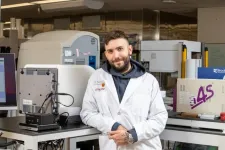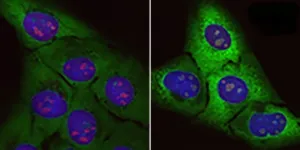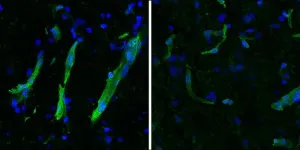Toronto researchers devise new way to find proteins for targeted treatment of disease
Method interrogates entire human proteome for effector proteins, which influence stability of other proteins via induced proximity
2024-03-22
(Press-News.org)
Researchers at the University of Toronto and Sinai Health have created a new platform to identify proteins that can be co-opted to control the stability of other proteins — a new but largely unrealized approach to the treatment of disease.
The researchers developed a method to interrogate the entire human proteome for ‘effector’ proteins, which can influence the stability of other proteins via induced proximity. The study marks the first time researchers have searched for effector proteins on this scale, and has identified many new effectors that could be used therapeutically.
“We found more than 600 new effector proteins in 14,000 genes,” said Juline Poirson, first author on the study and visiting scientist at U of T’s Donnelly Centre for Cellular and Biomolecular Research. “Over 200 of the new effectors can efficiently degrade their target proteins, while about 400 effectors were capable of stabilizing, and thereby increasing the abundance of, an artificial target protein.”
The study, which involved researchers at Sinai Health’s Lunenfeld-Tanenbaum Research Institute, was published in the journal Nature.
“Targeting proteins through induced proximity is a new and promising area of biomedical research,” said Mikko Taipale, principal investigator on the study and an associate professor of molecular genetics at the Donnelly Centre and the Temerty Faculty of Medicine. “Not only did we find new effectors worth further investigation for drug discovery, we developed a synthetic platform that can be used to conduct unbiased, proteome-wide, induced-proximity screens to continue expanding the library of effector proteins.”
The effectors currently in use for targeted protein degradation and stabilization are E3 ubiquitin-ligases (E3s) and deubiquitinases (DUBs), respectively. E3 is an enzyme that transfers the ubiquitin molecule to the target protein, which essentially flags the protein for a proteosome to digest it. On the other hand, a DUB enzyme removes the ubiquitin tag from a protein, thereby preventing the protein from being recognized and degraded by a proteosome.
The results of the study demonstrate that E3s are quite varied in the degree to which they can degrade target proteins they are brought into contact with. The research team even discovered four of what they call ‘angry E3s,’ which consistently degrade targets regardless of other factors, such as the location of the target within the cell.
A particularly surprising finding was that some of the strongest effectors for targeted protein degradation were E2 conjugating enzymes, instead of E3s. These differ from E3s in that they are involved at an earlier step of protein degradation and do not directly engage the target protein. Because E2s were not considered to be easily druggable, they had not been harnessed for targeted protein degradation until recently. They represent, however, the untapped potential of stronger effectors than ones currently in use.
The study shows that exploring the whole proteome for induced proximity offers enormous opportunities for therapeutic interventions. KLHL40, one of the identified effectors, could potentially be hijacked for targeted protein stabilization to treat skeletal muscle disorders. The research team also found that targeted protein degradation with FBXL12 and FBXL15 effectors could be particularly useful in treating chronic myeloid leukemia.
Targeted protein degradation and stabilization are innovative methods of drug discovery that have thus far been plagued with the “protein pair problem,” where the best effector for a target protein cannot be predicted accurately. Matching a target protein with the right effector is essential to successfully, and safely, facilitate degradation and stabilization processes in tissues.
“The synthetic screening platform developed by our team solves the protein matching issue through rapid, large-scale testing of effector and target protein interactions,” said Poirson. “We’re confident that an unbiased induced-proximity approach can be used to find effectors for almost any target.”
END
[Attachments] See images for this press release:


ELSE PRESS RELEASES FROM THIS DATE:
2024-03-22
Attention editors: Under embargo by the journal Nature Machine Intelligence until Friday, March 22, 12 p.m. eastern
Hamilton, ON, Mar. 22, 2024 – Researchers at McMaster University and Stanford University have invented a new generative artificial intelligence model which can design billions of new antibiotic molecules that are inexpensive and easy to build in the laboratory.
The worldwide spread of drug-resistant bacteria has created an urgent need for new antibiotics, but even modern AI methods are limited ...
2024-03-22
UNIVERSITY PARK, Pa. — Eating one avocado per day may improve overall diet quality, according to a team led by researchers in Penn State’s Department of Nutritional Sciences. Poor diet quality is a risk factor for many diseases, including heart disease, and many American adults have poor diet quality and do not meet key dietary recommendations provided by the Dietary Guidelines for Americans.
This study was led by Kristina Petersen, associate professor of nutritional sciences, and Penny ...
2024-03-22
AURORA, Colo. (March 22, 2024) – The health impacts of a complex protein that plays a major role in the development of Alzheimer’s disease and heart conditions can be lessened by three kinds of drug inhibitors, according to scientists at the University of Colorado Anschutz Medical Campus.
In an overview of the protein and the inhibitors published today in the journal Cell Reports, the CU researchers discussed the best ways to use the interventions.
The protein, CaMKII, is ubiquitous in cells throughout the body but is perhaps best known for its prominent role in the brain and the heart. It is critical in learning and memory but if misregulated can ...
2024-03-22
From photons to atheism to Churchill’s extraterrestrial musings, the stunning breadth of Carlo Rovelli’s work has spurred readers to think deeply about the intersection of science and culture, transforming staggering complexity into widely accessible writing along the way.
For this artful ability to educate and engage, Rovelli will be presented with the 2024 Lewis Thomas Prize for Writing about Science at The Rockefeller University on April 9. Named after its first recipient, noted physician-scientist and essayist Lewis Thomas, the prize was ...
2024-03-22
It’s no surprise that your dog can learn to sit when you say “sit” and come when called. But a study appearing March 22 in the journal Current Biology has made the unexpected discovery that dogs generally also know that certain words “stand for” certain objects. When dogs hear those words, brain activity recordings suggest they activate a matching mental representation in their minds.
“Dogs do not only react with a learned behavior to certain words,” says Marianna Boros (@FamDogProject) of the Department of Ethology at the Eötvös Loránd University, Budapest, Hungary, one of the paper’s co-first authors. “They also don’t ...
2024-03-22
It’s no surprise that dogs can learn to understand and respond to human words. Your dog can learn to sit when you say “sit” and come when called. But a new study has made the surprising discovery by recording brain activity that dogs generally also know that certain words “stand for” certain objects. When they hear those words, they activate a matching mental representation in their minds.
“Dogs do not only react with a learned behavior to certain words,” says Marianna Boros of the Department of Ethology at the Eötvös Loránd University, Budapest, Hungary. “They also don’t just associate that word with an object ...
2024-03-22
CNIO researchers provide a new hypothesis to understand the origin of amyotrophic lateral sclerosis, or ALS. It would be triggered by a similar problem to that occurring in a group of rare diseases called ribosomopathies.
In ALS patients, motor neurons would accumulate an excess of non-functional ribosomal proteins that eventually collapse the cell's clearance systems and cause toxicity.
The study also opens a new front in aging research. The authors provide experimental evidence that formally proves a kind of stress called ‘nucleolar stress’ cause aging in mammals.
Amyotrophic lateral sclerosis (ALS) is a degenerative disease. ...
2024-03-22
On the surface, the movement disorder amyotrophic lateral sclerosis (ALS), also known as Lou Gehrig’s disease, and the cognitive disorder frontotemporal lobar degeneration (FTLD), which underlies frontotemporal dementia, manifest in very different ways. In addition, they are known to primarily affect very different regions of the brain.
However, doctors and scientists have noted several similarities over the years, and a new study in Cell reveals that the diseases have remarkable overlaps at the cellular and molecular levels, revealing potential targets that could yield therapies applicable ...
2024-03-22
About The Study: In this study of 5,437 U.S. adults with health care visits in 2022, many patients, including those with the greatest care needs, chose telemedicine even after in-person visits were available. These findings support continuing this care delivery approach as an option valued by patients. Differences were not observed by most common measures of socioeconomic status. Continued monitoring of telemedicine use is needed to ensure equitable access to health care innovations.
Authors: Eva ...
2024-03-22
About The Study: The results of this study of Medicare enrollees suggest that although nationally, Black and Hispanic individuals and individuals of other racial groups received more telemedicine visits during the pandemic and disproportionately lived in geographic regions with higher telemedicine use, after controlling for geographic region, Black and Hispanic individuals and individuals of other racial groups received fewer telemedicine visits than white individuals.
Authors: Felippe O. Marcondes, M.D., M.P.H., of Massachusetts General ...
LAST 30 PRESS RELEASES:
[Press-News.org] Toronto researchers devise new way to find proteins for targeted treatment of disease
Method interrogates entire human proteome for effector proteins, which influence stability of other proteins via induced proximity





